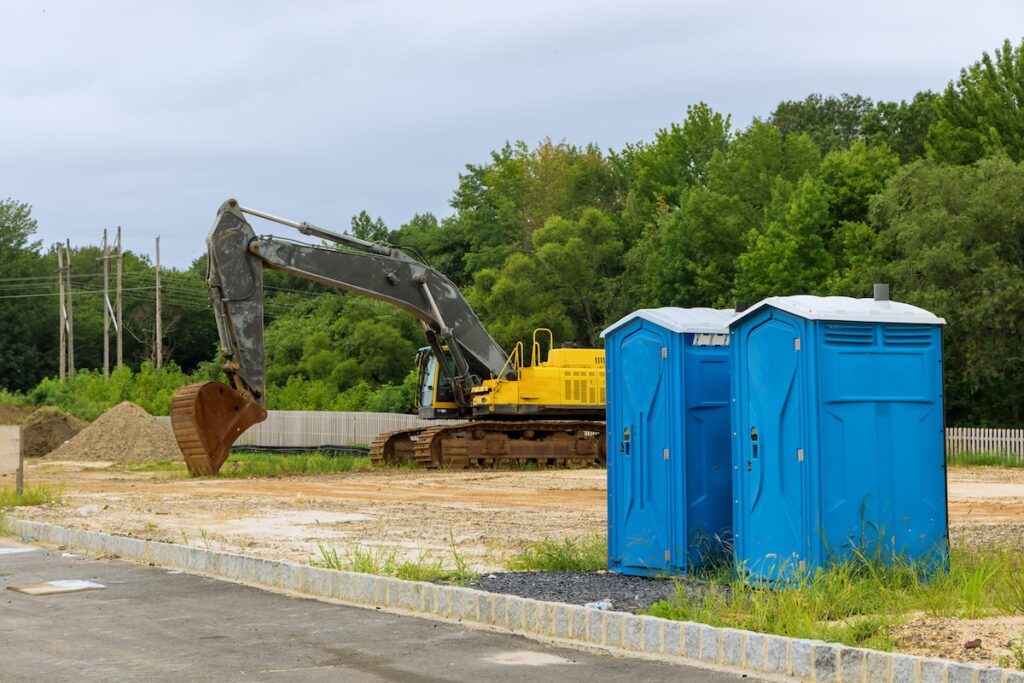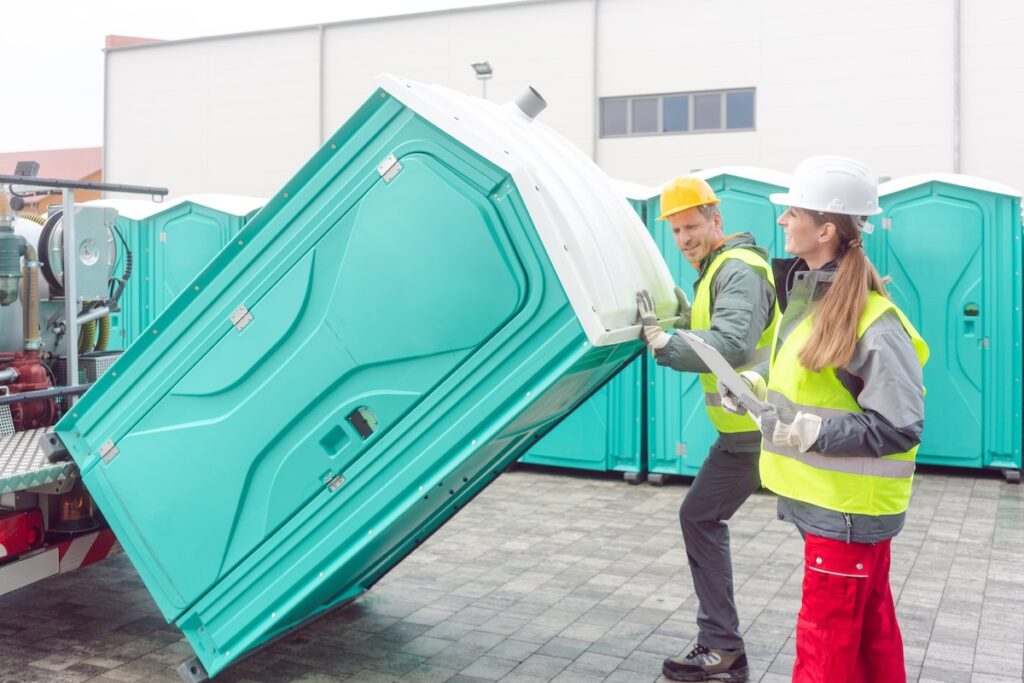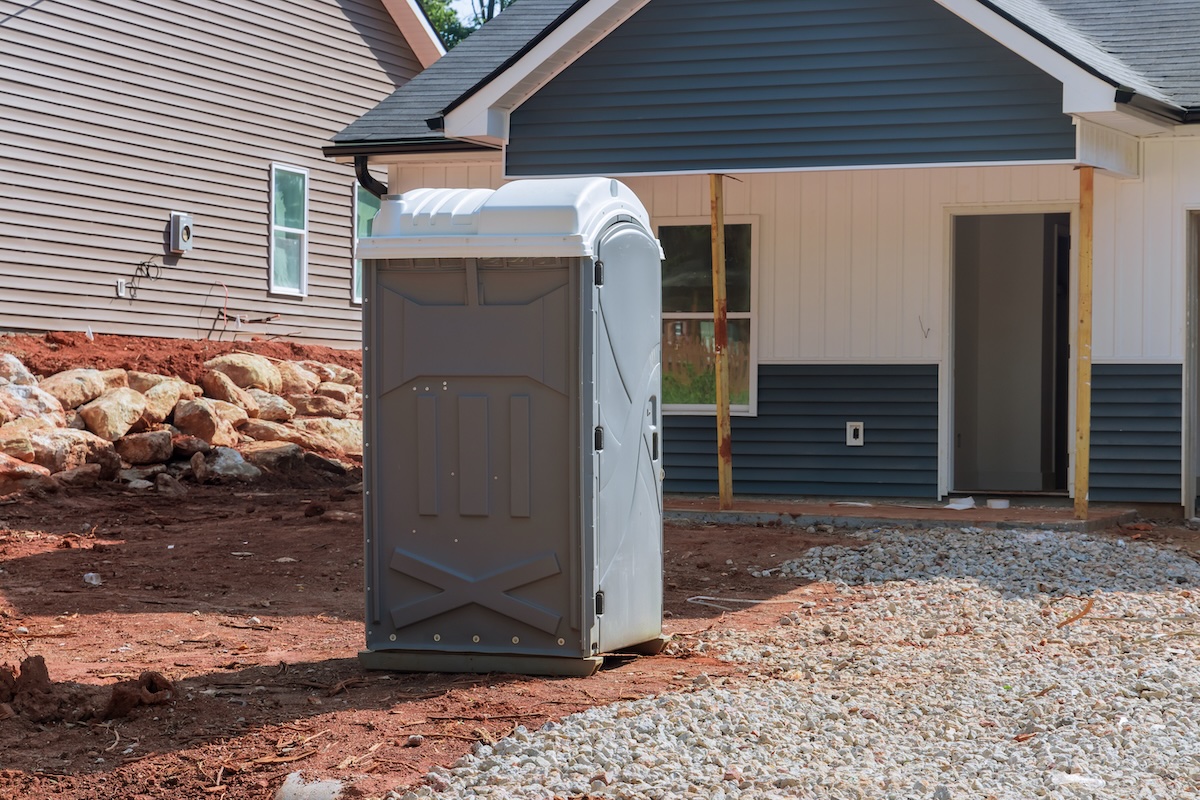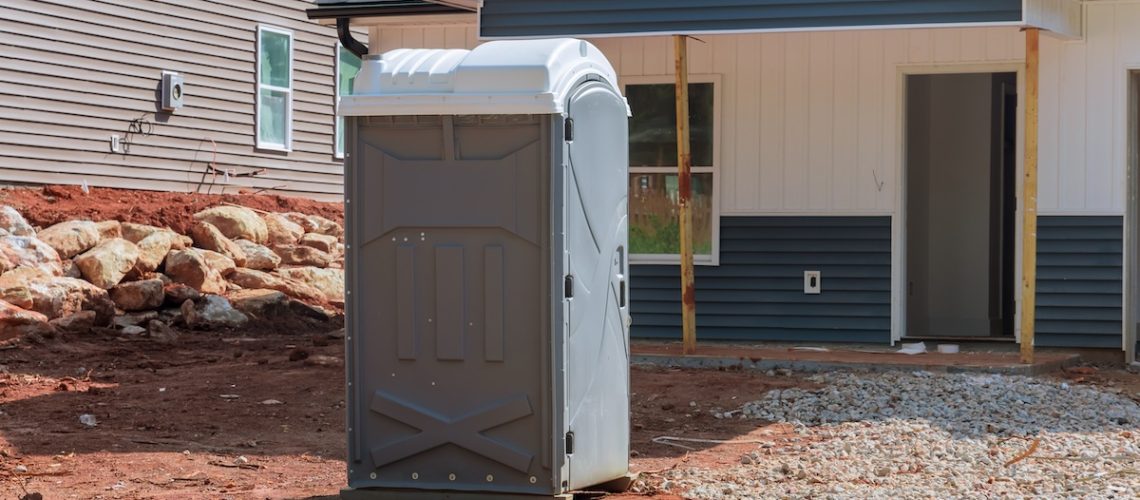Portable restrooms might not be the first thing that comes to mind when you think of a construction site, but they’re an important part of every project’s setup. In fact, under most state and federal regulations, portable sanitation facilities are required. The Occupational Safety and Health Administration (OSHA) mandates that all employers provide adequate toilet facilities for employees. On a construction site, this almost always means porta-potties, jobsite toilets, or mobile restroom trailers.
The reasoning is pretty simple: workers need safe, sanitary access to restrooms throughout the workday. Proper sanitation prevents disease, improves morale, boosts productivity, and keeps projects compliant with health codes. Beyond the (admittedly important) issue of compliance, portable restrooms also help maintain efficiency by lessening downtime and making sure the jobsite stays clean and organized overall.
So, let’s take a look at what the regulations require, how to plan how many porta potties to rent / how many units are needed, and why professional sanitation planning is so important for construction projects in the first place.
OSHA and Federal Requirements for Jobsite Restrooms
OSHA’s sanitation standards (29 CFR 1926.51) make restroom access a legal requirement on construction sites. The rule states that every employer must provide toilet facilities in a clean and sanitary condition. Because most jobsites do not have access to permanent plumbing, portable toilets are the accepted solution.
The minimum number of restrooms required depends on how many workers are present. OSHA sets these base requirements:
- 1 toilet for 20 or fewer employees
- 1 toilet seat and 1 urinal per 40 workers (21–200 employees)
- 1 toilet seat and 1 urinal per 50 workers (over 200 employees)
These are bare minimums. Larger or longer-term projects often need more to maintain cleanliness and avoid long lines. OSHA also emphasizes accessibility and hygiene, meaning that restrooms must be within reasonable walking distance, kept clean, and stocked with toilet paper and handwashing supplies.

Gender Accessibility
Where both male and female workers are employed, OSHA requires that restrooms be provided for each sex. While most construction crews remain male-dominated, mixed-gender teams are increasingly common, and project managers must plan accordingly. Portable sanitation companies can supply separate units clearly marked for men and women or designate multi-stall restroom trailers divided internally.
Handwashing and Hygiene
OSHA’s regulations also require proper handwashing facilities. This can mean portable sinks with running water and soap or hand sanitizer stations when water service isn’t feasible. Sites handling concrete, paints, adhesives, or chemicals are particularly subject to these hygiene standards, as many materials are skin irritants or contain hazardous residues.
Why Portable Toilets Are the Standard Solution
Construction sites are often temporary, remote, or constantly shifting as work progresses. Running plumbing or building permanent bathrooms is rarely practical. Portable toilets, sometimes called jobsite lavatories or temporary restrooms, solve this problem with a simple, self-contained design. Each unit holds waste in a sealed tank that can be serviced and sanitized regularly by a licensed waste-hauling company.
Beyond their convenience, portable toilets meet several essential needs:
- Mobility: Units can be repositioned as the site layout changes or as new phases of construction begin.
- Durability: Built from tough polyethylene and designed for outdoor use, they can withstand heavy winds, debris, and temperature changes.
- Cost-Efficiency: Renting portable toilets avoids the massive expense of installing and later removing plumbing infrastructure.
- Environmental Responsibility: Waste is collected and transported to approved treatment facilities, ensuring compliance with environmental standards.
For larger projects or extended durations, many companies upgrade to restroom trailers or mobile lavatories with flushing toilets, sinks, and climate control. These are especially useful for long-term builds, corporate contractors, or projects where on-site offices or clients are present.
Determining How Many Portable Restrooms You Need
While OSHA’s minimum table sets a baseline, there are several important factors that affect how many units a project might actually require. Overcrowded restrooms lead to sanitation problems and lower morale, and can also risk noncompliance.
Here are the key considerations:
- Crew Size: The larger the workforce, the more facilities you’ll need. Consider subcontractors and rotating shifts as part of your total headcount.
- Work Hours: Extended workdays or night shifts justify adding units or scheduling additional cleanings.
- Project Duration: For projects lasting several months or more, units must be serviced regularly, often weekly or more frequently.
- Site Layout: If crews are spread across a large area, more units are needed to keep restroom access within a short walk (usually 200 feet).
- Weather Conditions: Hot weather increases usage frequency and requires more frequent servicing to control odor and maintain sanitation.
- Amenities: Adding sinks, hand sanitizer stations, or combination units improves compliance and hygiene ratings.
Many professional providers use a formula: 1 standard portable toilet per 10 workers for a 40-hour week. If overtime or multiple shifts are scheduled, increase accordingly.
Legal and Local Code Compliance
In addition to OSHA, state and local authorities may have their own health and sanitation regulations. Municipal building departments or health departments often inspect construction sites for compliance. Noncompliance can lead to fines, stop-work orders, or revocation of permits.
Some typical requirements include:
- Documentation of service intervals and waste removal records
- Proof that units were cleaned and stocked regularly
- Proper disposal at licensed wastewater facilities
- Placement away from open water, food areas, or living quarters
Local ordinances may also specify how close portable restrooms must be placed to workers or how they must be secured on uneven ground. For example, some cities require restrooms to be on level surfaces, anchored during high-wind seasons, or equipped with hand sanitizer when water lines are unavailable.
Working with a reputable portable sanitation provider can help make sure all these local rules are met. A professional company will be familiar with local inspectors, permitting requirements, and the frequency of servicing needed to remain compliant.

The Impact of Proper Sanitation on Worker Productivity
A clean, well-maintained restroom setup might not sound like a productivity tool, but it is. Studies have shown that workers who have easy access to clean restrooms lose less time walking to off-site facilities or taking unscheduled breaks. More importantly, proper hygiene reduces illness, skin irritation, and the spread of bacteria.
Without adequate facilities, workers may resort to unsanitary alternatives, leading to contamination risks and low morale. The difference between a jobsite with overflowing portable toilets and one that’s serviced regularly can be the difference between a workforce that feels respected and one that doesn’t.
Professional portable restroom providers schedule weekly or twice-weekly servicing, which includes:
- Pumping out waste tanks
- Cleaning and deodorizing interiors
- Replacing paper and sanitizer supplies
- Inspecting for damage or leaks
This consistent care keeps the environment safe and prevents complaints or violations.
Types of Portable Restrooms Used on Construction Sites
Portable sanitation options come in several configurations depending on project size and crew needs. Construction companies often mix and match to create a balanced setup.
Standard Units
The classic single portable restroom, often called a construction toilet or field unit, features a toilet, urinal, ventilation stack, and toilet paper dispenser. These are durable, easy to relocate, and meet OSHA requirements for most short-term projects.
High-Rise Units
These compact, liftable versions are designed for multi-story construction. They can be hoisted by crane or elevator and placed on upper floors to save time and reduce worker travel distance.
ADA-Compliant Restrooms
Accessible units feature a wider door, flat entry, and handrails to comply with the Americans with Disabilities Act (ADA). Any public or multi-employer site must include at least one ADA-compliant unit.
Restroom Trailers
Larger builds or projects hosting clients, engineers, or management teams sometimes upgrade to multi-stall restroom trailers. These include flushing toilets, sinks with running water, mirrors, and lighting. They are especially valuable for long-term projects or when corporate image matters.
Combination Units
Some units combine a standard jobsite toilet with a handwashing station or freshwater sink. These are common on jobs involving paint, chemicals, or food preparation areas.
Placement and Maintenance Best Practices
Placement strategy affects both compliance and convenience. Units should be:
- Located within 200 feet or a 5-minute walk of the work area
- Positioned on flat, dry ground away from open water or food storage
- Shielded from heavy equipment paths but accessible for servicing trucks
- Grouped logically near tool sheds, site trailers, or break areas
Servicing frequency depends on crew size and temperature. In hot climates or during summer months, odor and bacterial growth increase, requiring more frequent cleanings. In cold or wet conditions, ensuring traction and stability around portable restrooms prevents slip hazards.
When planning, remember that cleanliness influences worker morale and public perception. Construction sites often sit near populated areas, and foul odors or overflowing units can damage a company’s reputation as much as an OSHA citation.
Portable Restrooms and Environmental Responsibility
Modern portable toilets are more environmentally responsible than many realize. Waste is vacuum-pumped into sealed tanks and delivered to licensed treatment facilities for proper disposal. The blue deodorizing liquid inside the holding tank contains enzymes that neutralize odor and break down waste safely.
Providers that focus on sustainability also use biodegradable chemicals and low-water systems. Some even offer solar-powered ventilation or LED lighting to reduce environmental impact. This attention to eco-standards benefits not only compliance but also public relations, particularly when working on municipal or environmentally sensitive projects.

Beyond the Basics: Upgrading Worker Comfort
While meeting OSHA’s minimum is mandatory, exceeding it can create a better workplace and attract skilled labor. Contractors who provide clean, comfortable facilities demonstrate respect for their crews and attention to detail.
Options for upgraded comfort include:
- Hands-free flushing systems and foot-operated sinks
- Deodorized interiors and air-freshened vents
- Lighting for night shifts
- Climate-controlled restroom trailers for long-term projects
These additions can have an outsized effect on worker satisfaction. A small investment in better facilities can reduce turnover and improve the perception of company culture on the jobsite.
Choosing a Portable Sanitation Provider
Selecting the right provider matters just as much as the number of units. A professional company can help ensure compliance, maintain cleanliness, and keep service on schedule. When choosing a vendor, consider the following:
- Experience with Construction Projects: Providers familiar with jobsite logistics understand delivery timing, access routes, and safety requirements.
- Licensing and Insurance: Proper waste transport licenses and liability coverage protect both the contractor and the property owner.
- Flexible Service Plans: Weekly, bi-weekly, or emergency cleanings can be adjusted as the project grows or changes.
- Quality of Equipment: Newer, well-maintained portable toilets reduce odor and improve worker satisfaction.
- Responsive Support: A good provider handles repairs or replacements quickly to prevent downtime.
Reliable communication and regular servicing schedules are signs of a partner that understands construction timelines and regulatory inspections.
Consequences of Noncompliance
Ignoring restroom requirements can lead to immediate OSHA citations and costly project delays. Fines for sanitation violations can reach thousands of dollars per infraction. More critically, repeated offenses damage a company’s safety record and make it harder to secure future contracts.
Other potential consequences include:
- Stop-work orders until facilities are installed
- Negative media coverage when sanitation issues affect nearby communities
- Reduced worker morale and higher absenteeism due to poor conditions
- Loss of bonding eligibility for public projects that require verified safety compliance
Maintaining compliant portable toilets or jobsite restrooms is a simple, cost-effective way to prevent these outcomes.
Keeping Projects Safe, Compliant, and Productive
Portable restrooms, jobsite toilets, and mobile lavatories might seem secondary compared to cranes and concrete, but they are an essential part of every safe and efficient construction site. OSHA mandates them, workers depend on them, and proper sanitation supports productivity and reputation alike.
Every contractor should view portable sanitation not as an afterthought but as part of the site’s operational backbone. Clean, well-serviced restrooms demonstrate professionalism, protect health, and make sure that every member of the crew can focus on their work without discomfort or distraction.
At MCS Portable Restrooms, we help builders and contractors meet these exact standards with dependable service, clean facilities, and flexible rental plans designed for construction environments. From single-unit setups to full-scale restroom trailers, our team keeps your site compliant, efficient, and ready for inspection. Contact us today to arrange your construction site restroom plan and keep your project running smoothly from the ground up.


